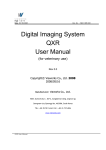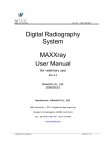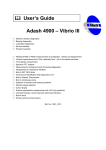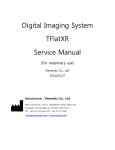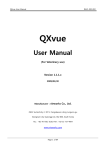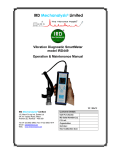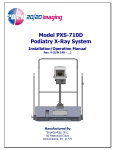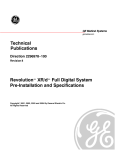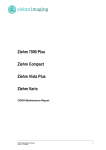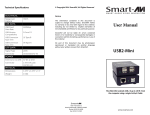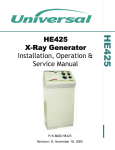Download QXR Service Manual for veterinary use
Transcript
Digital Imaging System QXR Service Manual (For veterinary use) vieworks Co., Ltd. 2009/03/17 Manufacturer : vieworks Co., Ltd. #604, SuntechcityⅡ, 307-2, Sangdaewon-dong Jungwon-gu Seongnam-city Gyeonggi-do, 462-806, South Korea TEL : +82-70-7011-6161 FAX : +82-31-737-4954 www.vieworks.com QXR Service Manual RA21-093-002 Revision History Rev 0.0 17 Mar. 2009 First release Page 2 of 66 QXR Service Manual RA21-093-002 Accident Reporting The FDA Medical Device Reporting regulation, 21, CFR 803 and the CE Council Directive 93/42/EEC concerning Medical Devices require that “the manufacturer of medical devices submit a report to the FDA or Local competent authorities whenever he becomes aware of information that reasonably suggests that one of his installed devices: ● may have caused or contributed to a death or serious injury, or ● has malfunctioned and, if the malfunction recurs, is likely to cause or contribute to a death or serious injury. In order for Vieworks to comply with these requirements, all users of this equipment, operators and service technicians, are required to provide the Quality Assurance Manager at vieworks with the following information regarding all reportable events as soon as possible: 1) Identification of the model and serial number. 2) Description of the event including whether any serious injury or death has been occurred. 3) Identification of the person who is submitting the information including phone number and fax number if available. Reference to standards EN60601-1 Medical electrical equipment Part 1: general requirements for safety EN60601-2-32 Medical electrical equipment Part 2: Particular requirement for the safety of associated equipment of X-ray equipment EN60601-1-2 Medical electrical equipment Part 2: electromagnetic compatibility–requirements and tests Authorized representatives If you have any accident, please contact the authorized representatives Page 3 of 66 QXR Service Manual RA21-093-002 Table of Contents Revision History ............................................................................................................................................................ 2 Accident Reporting....................................................................................................................................................... 3 Reference to standards ............................................................................................................................................... 3 Authorized representatives ........................................................................................................................................ 3 Table of Contents .......................................................................................................................................................... 4 1. Safety ........................................................................................................................................................................... 8 1.1 Safety Guidelines ................................................................................................................................................... 8 1.2 General Hazards ..................................................................................................................................................... 9 1.2.1 Radiation hazards ....................................................................................................................................... 9 1.2.2 Electric shock hazard ................................................................................................................................. 9 1.2.3 Explosion Hazard ........................................................................................................................................ 9 1.2.4 Implosion Hazard ....................................................................................................................................... 9 1.3 Owner’s Responsibility ......................................................................................................................................... 9 1.4 System Diagnostic ............................................................................................................................................... 10 1.5 Calibration.............................................................................................................................................................. 10 1.6 Distances measurements ................................................................................................................................... 10 1.7 Left/Right Marker ................................................................................................................................................ 10 1.8 Images Back-up .................................................................................................................................................... 11 1.9 User Limitations ................................................................................................................................................... 11 1.10 Cleaning the system ......................................................................................................................................... 11 1.11 Overheating ......................................................................................................................................................... 11 1.12 Electrical fire ....................................................................................................................................................... 11 1.13 EMI/EMC Precaution ......................................................................................................................................... 11 1.15 Maintenance precautions ................................................................................................................................ 18 1.16 Disposal ................................................................................................................................................................ 18 1.17 Changing Fuse .................................................................................................................................................... 18 1.18 Others ................................................................................................................................................................... 18 1.19 Appropriation ..................................................................................................................................................... 19 1.20 Using together with other equipment ........................................................................................................ 19 1.21 Classification (UL) .............................................................................................................................................. 19 1.22 Installation and Maintenance ......................................................................................................................... 19 2. System Description ................................................................................................................................................ 20 2.1 Intended use ......................................................................................................................................................... 20 2.2 System components ............................................................................................................................................ 20 2.3 Component description ..................................................................................................................................... 21 3. System Specification ............................................................................................................................................. 22 Page 4 of 66 QXR Service Manual RA21-093-002 3.1 CCD .......................................................................................................................................................................... 22 3.2 Area of Image ....................................................................................................................................................... 22 3.3 Scintillator .............................................................................................................................................................. 22 3.4 Time of capture and transmission .................................................................................................................. 22 3.5 CCD Cooling System ........................................................................................................................................... 22 3.6 Image Specification ............................................................................................................................................. 22 3.7 Image Tilt ............................................................................................................................................................... 22 3.8 Image Distortion .................................................................................................................................................. 22 3.9 Dynamic Range..................................................................................................................................................... 23 3.10 Black Level ........................................................................................................................................................... 23 3.11 Resolution ............................................................................................................................................................ 23 3.12 Electrical Specification ..................................................................................................................................... 23 3.12.1 AC Power Input (PSU) ........................................................................................................................... 23 3.12.2 Power Consumption .............................................................................................................................. 23 3.13 Interface ............................................................................................................................................................... 24 4. System Installation................................................................................................................................................. 25 4.1 RXDN-USB2N Installation .................................................................................................................................. 25 4.1.1 Hardware Installation .............................................................................................................................. 25 4.1.2 Software Installation ................................................................................................................................ 25 4.2 RXDN-USB2M Installation ................................................................................................................................. 28 4.2.1 Hardware Installation .............................................................................................................................. 28 4.2.2 Software Installation ................................................................................................................................ 29 4.3 QXvue Installation ............................................................................................................................................... 31 4.4 Hardware Installation ......................................................................................................................................... 35 4.4.1 Connect Cable to Detector (For Veterinary Use) ............................................................................. 35 4.4.2 Connect Other Cables.............................................................................................................................. 36 5. Preparation for operating QXR system ............................................................................................................ 38 5.1 Select USB Image Grabber and QXR type .................................................................................................... 38 5.2 Diagnosis and calibration .................................................................................................................................. 39 5.3 Configuration of QXvue ..................................................................................................................................... 39 6. Diagnosis .................................................................................................................................................................. 40 6.1 Procedures of Diagnostic .................................................................................................................................. 40 6.2 Preparation for Diagnostic ................................................................................................................................ 40 6.3 Password Input ..................................................................................................................................................... 40 6.4 Serial Communication Test ................................................................................................................................ 40 6.5 Set parameter of Detector ................................................................................................................................ 41 6.6 CCD Cooling Test ................................................................................................................................................. 42 6.7 Black Level Test .................................................................................................................................................... 42 6.8 Flat Field Test ........................................................................................................................................................ 43 Page 5 of 66 QXR Service Manual RA21-093-002 6.9 Save Result of Diagnosis ................................................................................................................................... 43 7. Calibration ................................................................................................................................................................ 44 7.1 Procedures of Calibration .................................................................................................................................. 44 7.2 Preparation for Calibration ............................................................................................................................... 44 7.3 Acquire Black image ........................................................................................................................................... 45 7.4 Acquire 20% flat field image ............................................................................................................................ 46 7.5 Acquire 40% flat field image ............................................................................................................................ 47 7.6 Acquire 60% flat field image ............................................................................................................................ 48 7.7 Distortion Correction .......................................................................................................................................... 49 7.8 Adjust FOV (Field of view) ................................................................................................................................ 50 7.9 Generate Calibration Data ................................................................................................................................. 51 7.10 Test Calibration Data ........................................................................................................................................ 52 7.10.1 Resolution test ........................................................................................................................................ 53 8. QXvue Configuration ............................................................................................................................................ 54 8.1 What is Configuration? ...................................................................................................................................... 54 8.2 General parameter setting ................................................................................................................................ 54 8.2.1 Hospital information ............................................................................................................................... 55 8.2.2 USB Image Grabber Selection ............................................................................................................... 55 8.2.3 QXR type ..................................................................................................................................................... 55 8.2.4 Detector direction compensation ........................................................................................................ 55 8.2.5 Thumbnail tab information.................................................................................................................... 55 8.2.6 Expansion setting ..................................................................................................................................... 56 8.2.7 DICOM header info .................................................................................................................................. 56 8.2.8 Dummy fields display name .................................................................................................................. 56 8.2.9 Patient comparison condition ............................................................................................................... 56 8.2.10 File-worklist location ............................................................................................................................. 56 8.3 DICOM parameter setting ................................................................................................................................. 57 8.3.1 Worklist & PACS ....................................................................................................................................... 57 8.3.2 File-worklist ................................................................................................................................................ 58 9. Trouble Shooting .................................................................................................................................................... 59 9.1 Failure Mode ......................................................................................................................................................... 59 9.2 Repairing Power Failure ..................................................................................................................................... 60 9.3 Repairing RS232 communication Failure ....................................................................................................... 60 9.4 CCD Cooling Test Failure.................................................................................................................................... 60 9.5 Black Level Test Failure....................................................................................................................................... 60 9.6 Flat Field Test Failure .......................................................................................................................................... 60 9.7 Resolution Test Failure ....................................................................................................................................... 60 10. WARRANTY ........................................................................................................................................................... 61 Appendix A QXR Interconnection Diagram .................................................................................................... 62 Page 6 of 66 QXR Service Manual RA21-093-002 Appendix B Symbols ............................................................................................................................................. 63 Appendix C How to use line trigger ................................................................................................................. 64 Appendix D Drawings ........................................................................................................................................... 66 Page 7 of 66 QXR Service Manual RA21-093-002 1. Safety 1.1 Safety Guidelines Caution Always be alert when operating this equipment. If a malfunction occurs, do not use this equipment until qualified personnel correct the problem. This Product was designed and manufactured to ensure maximum safety of operation and to meet all the safety requirements applicable to electronic medical equipment. However, anyone attempting to operate the system must be fully aware of potential safety hazards. It should be operated and maintained in strict compliance with the following safety precautions and operating instruments contained herein: 1) The product should be installed, maintained and serviced according to Vieworks maintenance procedures and by Vieworks personnel or other qualified maintenance personnel approved in writing by Vieworks. Operation and maintenance should be done in strict compliance with the operation instructions contained in the maintenance manuals. 2) The system, in whole or in part, cannot be modified in any way without written approval from vieworks. 3) Before authorizing any person to operate the system, verify that the person has read and fully understand the Service Manual. The owner should make certain that only properly trained and fully qualified personnel are authorized to operate the equipment. An authorized operators list should be maintained. 4) Prevent unauthorized personnel from access to the system. 5) It is important that this Service Manual be kept at hand, studied carefully and reviewed periodically by the authorized operators. 6) The owner should ensure continuous power supply to the system, with voltage and current according to the product specifications. If power failures are not infrequent, a UPS (Uninterrupted Power Supply) should be installed to avoid loss of data. 7) If the product does not operate properly or if it fails to respond to the controls described in this manual, the operator should immediately contact Vieworks field service representative, report the incident and await further instructions. 8) The images and calculations provided by this system are intended to be used as tools for the competent user. They are explicitly not to be regarded as a sole incontrovertible basis for clinical diagnosis. Users are encouraged to study the literature and reach their own professional conclusions regarding the clinical utility of the system. 9) The user should be aware of the product specifications and of the system‟s accuracy and stability limitations. These limitations must be considered before making any decision based on quantitative Page 8 of 66 QXR Service Manual RA21-093-002 values, in case of doubt, please consult a Vieworks representative. 1.2 General Hazards 1.2.1 Radiation hazards This system can be interfaced to x-ray generating equipment. Be certain to follow the safety instructions and specifications for wearing proper lead shielding when in the presence of x-ray generating equipment. All personnel must wear dosimeters during all phases of installation, operation and maintenance of the system and the equipment to which it is interfaced. 1.2.2 Electric shock hazard A three conductor AC power is supplied with this system to provide the proper electrical grounding. To minimize the shock hazard, the power cable must be plugged into a UL-approved three-contact electrical outlet. Do not remove or open system covers or plugs. The internal circuits of the system use high voltages that can cause serious injury or death from electrical shock. The operator should never be allowed to open the panels of the system. 1.2.3 Explosion Hazard Do not operate the equipment in the presence of flammable or explosive liquids, vapors or gases. Do not plug in or turns on the system in hazardous substances are detected in the environment. If flammable substances are detected after the system has been turned on, do not attempt to turn off the system or unplug it. Evacuate and ventilate the area before turning the system off. 1.2.4 Implosion Hazard Do not subject the system to serious mechanical shocks, as the cathode ray tube (CRT) can explode if struck or jarred. This may result in flying pieces of glass and coating that can cause serious injury. 1.3 Owner’s Responsibility Caution Do not use the system if unsafe conditions are known to exist. In case of hardware failure that could cause hazardous conditions (smoke, fire and etc), turn the power OFF and unplug the power cords of all subsystems. The owner is responsible for ensuring that anyone using the system reads and understand the Service Manual and other relevant literature, and fully understands them. Vieworks makes no representation, Page 9 of 66 QXR Service Manual RA21-093-002 however, that the act of reading this manual renders the reader qualified to operate, test and calibrate the system. 1.4 System Diagnostic The QXvueCalibration software runs a system diagnostic. Run QXvueCalibration software when install system or every 1 year after installation. If an error is detected, report detailed error to Vieworks field service representative. Caution The owner is responsible for ensuring that diagnostic of system is performed every year. Do not try to use the system if system diagnostic is fail. 1.5 Calibration To ensure the optimal performances of the system it is important to verify that system is calibrated. Caution The owner is responsible for ensuring that the system calibration is performed at installation time or if the system is repaired. Do not try to use the system if system calibration is not performed. 1.6 Distances measurements Distances measurements in millimeters are possible only after distance calibration has been performed using a reference object (see operation manual). Caution The operator is responsible for performing distance calibration with a reference object and verifying the results of the distance calibration before taking any distance measurements on an image. 1.7 Left/Right Marker The operator is responsible for the correct and clear marking on the left or right side of the image to eliminate possible errors. The software includes an option to mark the image with L (left) or R (right) indicator from acquisition phase through printing and archiving. If the operator chose, for any reason, not to use L/R markers, he must use an alternative way to eliminate any possible mistake. Page 10 of 66 QXR Service Manual RA21-093-002 1.8 Images Back-up To avoid the possibility of losing images, which might result in patient being exposed to additional doses of radiation, it is important to back-up the images by filming or by using the CD or DVD option. This should be done as a routine operation for every patient. If the hard disk of workstation is about to full, the operator should back-up images and delete the images to make room on hard disk for new patient. Caution The operator is responsible for backing-up images of each patient. Do not accumulate images in the system without having a back-up. 1.9 User Limitations The QXvue software has the technician mode, this mode could only be operated with the inputting PASSWORD. The technician mode should be operated by the personnel who are qualified by Vieworks. 1.10 Cleaning the system Use only isopropyl alcohol to clean surfaces of the system. Do not use detergents or organic solvents to clean the system. Strong detergent, and organic cleaners may damage the finish and cause structural weakening. Do not clean the system with turning the power on. 1.11 Overheating Do not block the ventilation ports of the detector to prevent overheating of the detector. Overheating can cause system malfunction and damages. 1.12 Electrical fire ● This equipment is not suitable for use in the presence of a flammable an aesthetic mixture with air or with oxygen or nitrous oxide. ● Conductive fluids that drain into the active circuit components of the system may cause short circuits that can result in electrical fire. Therefore, do not place fluids or food on any part of the system. ● To avoid electric shocks and burns caused by use of the wrong type of fire extinguisher, make sure that the fire extinguisher at the site has been approved for use on electrical fires. 1.13 EMI/EMC Precaution During installation of the system, care must be taken to prevent the potential risk of electromagnetic interference between this equipment and other devices. The device has been tested for EMI/EMC compliance, but interference can still occur in an electromagnetically noisy environment. Page 11 of 66 QXR Service Manual RA21-093-002 Attempt to maintain a suitable distance between electrical devices to prevent cross-interference. 1.14 EMC Information 1.14.1 Guidance and manufacturer’s declaration - electromagnetic emissions The EUT is intended for use in the electromagnetic environment specified below. The customer or the user of the EUT should assure that it is used in such an environment. Immunity test Compliance RF Emissions Group 1 CISPR 11 Electromagnetic environment -guidance The EUT uses RF energy only for its internal function. Therefore, its RF emissions are very low and are not likely to cause any interference in nearby electronic equipment RF Emissions Class B CISPR 11 The EUT is suitable for use in ail establishments, including domestic establishments and those directly connected to the public low-voltage power supply network that supplies buildings used for domestic purposes Harmonic emissions Class A IEC 61000-3-2 Voltage fluctuations/ Complies Flicker emissions IEC 61000-3-3 1.14.2 Guidance and manufacturer’s declaration - electromagnetic immunity The EUT is intended for use in the electromagnetic environment specified below. The customer or the user of the EUT should assure that it is used in such an environment. Immunity test IEC 60601 Compliance level Electromagnetic environment -guidance Test level Electrostatic ±6kV Contact ±6kV Contact Floors should be wood, concrete or discharge (ESD) ±8kV air ±8kV air ceramic tile. If floors are covered with IEC 61000-4-2 synthetic material, the relative humidity should be at least 30%. Electrical fast ±2kV for power ±2kV for power Mains power quality should be that of a transient/burst supply lines supply lines typical commercial or hospital IEC 61000-4-4 ± 1kV for ± 1kV for environment. input/output input/output lines lines Page 12 of 66 QXR Service Manual RA21-093-002 Surge ±1kV differential ±1kV differential Mains power quality should be that of a IEC 61000-4-5 mode mode typical commercial or hospital ±2kV common ±2kV common environment. mode mode Voltage dips, <5% Uт <5% Uт Mains power quality should be that of a short (>95% dip in Uт) (>95% dip in Uт) typical commercial or hospital interruptions and for 0.5cycle for 0.5cycle environment. If the user of the EUT voltage 40% Uт 40% Uт image intensifier requires continued variations (60% dip in Uт ) (60% dip in Uт ) operation during power mains on power supply for 5 cycle for 5 cycle interruptions, input lines 70% Uт 70% Uт it is recommended that the IEC 61000-4-11 (30% dip in Uт) (30% dip in Uт) EUT image intensifier is powered from for 25 cycle for 25 cycle an uninterruptible power supply or a <5% Uт <5% Uт battery. (<95% dip in (<95% dip in Uт ) Uт ) for 5 s for 5 s Power frequency 3 A/m 3 A/m Power frequency magnetic fields should (50/60Hz) be at levels characteristic of a typical magnetic field location in a typical commercial or IEC 61000-4-8 hospital environment. NOTE Uт is the a.c. mains voltage prior to application of the test level. Page 13 of 66 QXR Service Manual RA21-093-002 1.14.3 Guidance and manufacturer’s declaration – electromagnetic immunity The EUT is intended for use in the electromagnetic environment specified below. The customer or the user of the EUT should assure that it is used in such an environment. Immunity test IEC 60601 Compliance test level level Conducted RF 3 Vrms IEC 61000-4-6 150 kHz to 80MHz 3 Vrms 150 kHz to 80MHz Electromagnetic environment - guidance Portable and mobile RF communications equipment should be used no closer to any part of the EUT, including cables, than the recommended separation distance calculated from the equation applicable to the frequency of the transmitter. Recommended separation distance Radiated RF 3 V/m IEC 61000-4-3 80 MHz to 2.5GHz 3 V/m 80MHz to 2.5GHz Where P is the maximum output power rating of the transmitter in watts (W) according to the transmitter manufacturer and d is the recommended separation distance in meters (m). Field strengths from fixed RF transmitters, as detera mined by an electromagnetic site survey, should be less than the compliance level in each frequency range. b Interference may occur in the vicinity of equipment marked with the following symbol : Page 14 of 66 QXR Service Manual RA21-093-002 NOTE 1) At 80MHz and 800MHz, the higher frequency range applies. NOTE 2) These guidelines may not apply in all situations. Electromagnetic propagation is affected by absorption and reflection from structures, objects and people. a Field strengths from fixed transmitters, such as base stations for radio (cellular/cordless) telephones and land mobile radios, amateur radio, AM and FM radio broadcast and TV broadcast cannot be predicted theoretically with accuracy. To assess the electromagnetic environment due to fixed RF transmitters, an electromagnetic site survey should be considered. If the measured field strength in the location in which the EUT is used exceeds the applicable RF compliance level above, the EUT should be observed to verify normal operation. If abnormal performance is observed, additional measures may be necessary, such as re-orienting or relocating the EUT. b Over the frequency range 150kHz to 80MHz, field strengths should be less than [V1] V/m. Page 15 of 66 QXR Service Manual RA21-093-002 1.14.4 Recommended separation distances between portable and mobile RF communications equipment and the EUT The is intended for use in an electromagnetic environment in which radiated RF disturbances are controlled. The customer or the user of the EUT can help Prevent electromagnetic interference by maintaining a minimum distance between portable and mobile RF communications equipment (transmitters) and the EUT as recommended below, according to the maximum output power of the communications equipment. Rated maximum Separation distance according to frequency of transmitter output power [m] of transmitter 150kHz to 80MHz [W] V1=3Vrms 80MHz to 800MHz to 800MHz 2.5GHz E1=3V/m E1=3V/m 0.01 0.116 0.1166 0.2333 0.1 0.368 0.3687 0.7378 1 1.166 1.1660 2.3333 10 3.687 3.6872 7.3785 100 11.660 11.6600 23.333 For transmitters rated at a maximum output power not listed above, the recommended separation distance d in meters (m) can be estimated using the equation applicable to the frequency of the transmitter, where p is the maximum output power rating of the transmitter in watts (W) according to the transmitter Manufacturer. NOTE 1) At 80MHz and 800MHz, the separation distance for the higher frequency range applies. NOTE 2) These guidelines may not apply in all situations. Electromagnetic propagation is affected by absorption and reflection from structures, objects and people. Page 16 of 66 QXR Service Manual RA21-093-002 1.14.5 Immunity and Compliance Level Immunity test IEC 60601 Test Level Actual Immunity Compliance Level Level Conducted RF 3Vrms IEC 61000-4-6 150kHz to 80MHz Radiated RF 3Vrms IEC 61000-4-3 80MHz to 2.5GHz 3Vrms 3Vrms 3V/m 3V/m 1.14.6 Guidance and manufacturer’s declaration - electromagnetic immunity The EUT is intended for use in the electromagnetic environment specified below. The customer or the user of the EUT should assure that it is used in such an electromagnetic environment. Immunity test IEC 60601 Compliance test level level Conducted RF 3 Vrms IEC 61000-4-6 150 kHz to 80MHz Electromagnetic environment - guidance 3 Vrms The EUT must be used only in a shielded location 150 kHz to with a minimum RF shielding effectiveness and, for 80MHz each cable that enters the shielded location with a minimum RF shielding effectiveness and, for each cable that enters the shielded location Field strengths outside the shielded location from Radiated RF 3 V/m IEC 61000-4-3 80 MHz to 2.5GHz 3 V/m 80MHz to 2.5GHz fixed RF transmitters, as determined by an electromagnetic site survey, should be less than 3V/m. a Interference may occur in the vicinity equipment marked with the following symbol: Page 17 of 66 of QXR Service Manual RA21-093-002 NOTE 1) These guidelines may not apply in all situations. Electromagnetic propagation is affected by absorption and reflection from structures, objects and people. NOTE 2) It is essential that the actual shielding effectiveness and filter attenuation of the shielded location be verified to assure that they meet the minimum specification. a Field strengths from fixed transmitters, such as base stations for radio (cellular/cordless) telephones and land mobile radios, amateur radio, AM and FM radio broadcast and TV broadcast cannot be predicted theoretically with accuracy. To assess the electromagnetic environment due to fixed RF transmitters, an electromagnetic site survey should be considered. If the measured field strength outside the shielded location in which the EUT is used exceeds 3V/m, the EUT should be observed to verify normal operation. If abnormal performance is observed, additional measures may be necessary, such as relocating the EUT or using a shielded location with a higher RF shielding effectiveness and filter attenuation. 1.15 Maintenance precautions Do not open enclosures, disconnect or connect any cables or accessories. Only qualified personnel by Vieworks can do the maintenance. 1.16 Disposal This product contains harmful materials such as lead. Improper disposal of this product may result in environmental contamination. When disposing of this equipment, contact Vieworks representative. Do not dispose of any part of this equipment without consulting a Vieworks representative first. Vieworks does not assume any responsibility for damage resulting from disposal of this equipment without consulting Vieworks. 1.17 Changing Fuse Caution For Continued Protection Against Risk of Fire, Replace Only with Same Type and rating of Fuse. Disconnect Power Before Changing Fuse. Use only fuse to meet the specification of the system when you replace fuse with another one. 1.18 Others Caution No User- Serviceable Parts Inside. Page 18 of 66 QXR Service Manual RA21-093-002 1.19 Appropriation Caution Don‟t make operation except for the intended purpose The system, in whole or in part, cannot be modified in any way without written approval from Vieworks. 1.20 Using together with other equipment Warning: When the unit is used together with other equipment in the patient area, the equipment shall be connected according to Standard UL 60601-1 and IEC 60601-1. 1.21 Classification (UL) 1) CLASS I EQUIPMENT 2) NO APPLIED 3) NO protection against ingress of water 4) NOT suitable for use in the presence of a flammable an aesthetic mixture with air or with Oxide 5) Continuous operation 1.22 Installation and Maintenance Caution Only qualified service personnel, who have received training from Vieworks should perform this installation and troubling shooting. Only qualified service personnel who have received training from vieworks should perform this installation and trouble shooting. Calibration procedures should be performed at the system installation time or if the x-ray generator is changed otherwise the system quality is decreased. Page 19 of 66 QXR Service Manual RA21-093-002 2. System Description 2.1 Intended use QXR system is indicated for digital imaging solution designed for general radiographic system for human or veterinary anatomy. It is intended to replace film or screen based radiographic systems in all general purpose diagnostic procedures. It controls x-ray exposure and x-ray dosage by means of interfacing with x-ray generator. Various features of this system enable the operator to diagnose easier and faster than conventional non-digital techniques. Computerized window, image inversion, image processing, zooming, panning, window level adjustment, contrast adjustment, and various features enable the operator to view diagnostic details difficult to see using conventional non-digital techniques. 2.2 System components QXR system consists of detector, image transfer device, power supply unit, software and its accessories. QXR system is classified into high-quality QXR-16 and middle-quality QXR-9. QXR-16 and QXR-9 use RXDN-8000D and RXDN-7000D respectively for their detector and share software and all other devices. QXR-16(9) system components Detector RXDN-8000D or RXDN-8100D(QXR-16) RXDN-7000D or RXDN-7100D(QXR-9) Image Transfer Device RXDN-USB2N, RXDN-USB2M Power Supply Unit RXDN-6000P-15 Software Viewer QXvue Configuration QXvueConfigure Calibration and Diagnostic QXvueCalibration Accessories Camera Interface Cable (25M, P/N : 1110-3517-01A) DC Power Cable (10M, P/N : 1200-3407-01A) RS232 Cable (25M, P/N : 1170-3414-01A) Generator Interface Cable (15M, P/N:1170-3417-01A) Workstation (option) OS Windows XP professional CPU Minimum Pentium 4, 3.0 GHz Memory Minimum 2G Byte Hard Disk Minimum 80G Byte Ethernet Minimum 100 Mbit/s Monitor 1600x1200, Color CD Rom CD or DVD R/W Page 20 of 66 QXR Service Manual X-ray grid(option) RA21-093-002 12:1 or 13:1, 200lines/inch 2.3 Component description 1) Detector Create X-ray image by using CCD camera and output the result in RS-644 format. 2) Power supply unit Supply DC-power to detector. 3) Image transfer device Transfer the result from detector to workstation in USB2.0 specification. 4) QXvue Software to view X-ray image. Get image from detector, process it to ease the diagnostic, save it in database and manage it. 5) QXvueCalibration Diagnostic detector and report the result. Calibrate the system. 6) QXvueConfigure Configure parameters for QXR Digital Imaging System Page 21 of 66 QXR Service Manual RA21-093-002 3. System Specification 3.1 CCD CCD FFT (Full Frame Transfer) CCD Effective Pixel Number 4096 × 4096 (QXR-16) 3072 × 3072 (QXR-9) Cell pitch 9 ㎛ ×9 ㎛(QXR-16) 12 ㎛ ×12 ㎛(QXR-9) Fill factor 97% ~ 100% 3.2 Area of Image 17" X 17" 3.3 Scintillator Gadolinum (545nm peak) or CsI 3.4 Time of capture and transmission Shorter than 3.5 second 3.5 CCD Cooling System CCD cooling system cools CCD to reduce thermal noise of the image. 1) Cooling Element Thermoelectric Cooler (TEC) 2) Operation Temperature (CCD) Maintain -5±1℃ at 25℃ of surrounding temperature. 3) Cooling Speed (CCD) To be kept -5±1℃within 15 minutes after power on at 25℃ of surrounding temperature. 3.6 Image Specification 1) Image Format 4096(W) X 4096(H) (QXR-16) 3072(W) X 3072(H) (QXr-9) 2) Field of View Captured image should be reflected 100±2% of scintillator size (17”X17”) 3.7 Image Tilt The amount of the rotation of the captured image should not exceed 2° comparing with the subject on the screen. 3.8 Image Distortion Distortion (%) = 100*(A+A‟)/(B+C) , It should be within 4.5% under this formula Page 22 of 66 RA21-093-002 c B A A' QXR Service Manual 3.9 Dynamic Range 1) Definition In order to measure dynamic range properly, the below procedures is necessary. - Wait until CCD cooled enough after turning the detector power on. - Take a dark image using Diagnostic software. Suppose standard deviation (A) as an average pixel value of the pixels located within diameter of 10 pixels from the center of the image, and then dynamic range is defined as followings Dynamic Range = 20 log (16383/A) (dB) 2) Specification It should be more than 60㏈ 3.10 Black Level 1) Definition It is the average pixel value of the pixels located within diameter of 20 pixels from the center of the dark image. Dark image should be captured using Diagnostic software after cooling CCD enough. 2) Specification It should be 500 +/- 500(ADU) 3.11 Resolution It should be more than 4.6 lp/mm for QXR-16 and 3.5 LP for QXR-9 at the center of the detector screen. The measure resolution, follow the below procedure. - Locate resolution chart (Nuclear Associates Model : 07-523 or the equivalent) at the center of the detector screen with the diagonal position. - Line pairs that could be separated by adjusting window level are the resolution. 3.12 Electrical Specification 3.12.1 AC Power Input (PSU) 100 - 240VAC +/- 10%, 50/60Hz 3.12.2 Power Consumption Less than 95W (Detector itself) Page 23 of 66 QXR Service Manual RA21-093-002 3.13 Interface 1) Image data RS-644(LVDS) 2) System Control RS-232C 3) Image transfer USB2.0 4) RS-232 Baud rate : 19,200 bps Parity bit : Even Data bit : 8 bit Stop bit : 1 bit Page 24 of 66 QXR Service Manual RA21-093-002 4. System Installation 4.1 RXDN-USB2N Installation ※ If you have RXDN-USB2M, skip this section 4.1.1 Hardware Installation 1) Connect the power-cable and USB-cable to RXDN-USB2N Grabber 2) Turn the RXDN-USB2N power on 3) Connect the USB-cable to the PC 4.1.2 Software Installation If USB cable is connected with the RXDN-USB2N powered on, the following installation wizard will be executed automatically. 1) Select “Install from a list or specific location (Advanced)” then click “Next” button 2) Select “Search for the best driver in these location” and check “Include this location in the search” Page 25 of 66 QXR Service Manual RA21-093-002 and click “Browse” button. 3) Select folder in which driver file USB2.0 Grabber is located, then click “OK” button. Then following window will be displayed. Click “Next” Button. Page 26 of 66 QXR Service Manual RA21-093-002 4) Click “Continue Anyway” button 5) Click “Finish” button Page 27 of 66 QXR Service Manual RA21-093-002 4.2 RXDN-USB2M Installation ※ If you have RXDN-USB2N, skip this section 4.2.1 Hardware Installation 1) Connect the power-cable and USB-cable to RXDN-USB2M 2) Turn on the power switch of RXDN-USB2M 3) Connect the other end of the USB-cable to the PC Page 28 of 66 QXR Service Manual RA21-093-002 4.2.2 Software Installation If you connect the USB cable with RXDN-USB2M powered on, the following installation wizard will be executed automatically. 1) Select “Install from a list or specific location (Advanced)” then click “Next” button. 2) Select “Search for the best driver in these location” and check “Include this location in the search” and click “Browse” button. Page 29 of 66 QXR Service Manual RA21-093-002 3) Select folder in which driver file of RXDN-USB2M is located, then click “OK” button. If the following window will be displayed, click “Next” Button. 4) Click “Continue Anyway” button 5) Click “Finish” button Page 30 of 66 QXR Service Manual RA21-093-002 4.3 QXvue Installation 1) Insert QXvue CD in CD Drive 2) Run “Setup.exe” program then InstallShield Wizard will be displayed, click “Next” button 3) Input User Name and Organization, and select user, then click “Next” button Page 31 of 66 QXR Service Manual RA21-093-002 4) Select setup type as Complete then click “Next” button 5) “Ready to Install the Program” window will be displayed, press “Install” Button Page 32 of 66 QXR Service Manual RA21-093-002 6) “Installing QXvue” will be displayed, now the InstallShield is installing QXvue. 7) After finishing installation of QXvue, “InstallShield Wizard Completed” window will be displayed, Then press “Finish” button. 8) The following message box will be displayed, press “Yes” button to restart computer. Page 33 of 66 QXR Service Manual RA21-093-002 Now the QXvue software is successfully installed to the following directory. Software c:\program files\QXvue Data D:\QXvueData Executable File List QXvue.exe Viewer program QXvueCalibration.exe Calibration program QXvueConfigure Configure program To run QXvue, “East Asian Language” option in windows should be selected, if not , "Selected collating sequence not supported by the operating system" or “the selected order is not supported by this operating system” message will be displayed. To select this option 1. Start->Control Panel-> Regional and Language… 2. Check “Install files for East Asian languages” option and click “OK” button to install Page 34 of 66 QXR Service Manual RA21-093-002 4.4 Hardware Installation 4.4.1 Connect Cable to Detector (For Veterinary Use) RS232 Cable Camera Interface Cable Generator Interface Cable DC Power Cable 1) Connect RS-232 Cable 2) Connect Generator Interface Cable 3) Connect Camera Interface Cable 4) Connect DC Power Cable Page 35 of 66 QXR Service Manual RA21-093-002 4.4.2 Connect Other Cables 1) Connect DC Power cable to Power Supply Unit 2) Connect Camera Interface Cable to RXDN-USB2N ※ If you have RXDN-USB2M, skip this section 3) Connect Data cable to RXDN-USB2M ※ If you have RXDN-USB2N, skip this section ※ When install only one detector, connect data cable to left connector Page 36 of 66 QXR Service Manual RA21-093-002 4) Connect RS232C cable to COM port of the workstation ※ If you have RXDN-USB2M, skip this section 5) Connect RS232C cable to Com port of the RXDN-USB2M ※ If you have RXDN-USB2N, skip this section ※ When install only one detector, connect RS-232 cable to left connector 6) Plug in AC Power cable to power supply unit Page 37 of 66 QXR Service Manual RA21-093-002 5. Preparation for operating QXR system To operate QXR system, following step should be executed 1) Run QXvueConfigure 2) Select USB Image Grabber and QXR type 3) Exit QXvueConfigure 4) Run QXvueCalibration 5) Diagnosis and calibrate 6) Exit QXvueCalibration 7) Run QXvueConfigure 8) Do Configuration 9) Exit QXvueConfigure 5.1 Select USB Image Grabber and QXR type 1) Run QXvueConfigure in “C:\program files\QXvue” folder 2) Select USB Image Grabber and QXR type Page 38 of 66 QXR Service Manual RA21-093-002 5.2 Diagnosis and calibration Refer to clause 6 for diagnosis and clause 7 for calibration 5.3 Configuration of QXvue Refer to clause 8 Page 39 of 66 QXR Service Manual RA21-093-002 6. Diagnosis Check if the detector is operating normally after the installation of the Detector. This diagnostic procedure will check operating state of detector and will generate diagnostic file for reporting about installed detector. Diagnostic will be performed in following sequence with the diagnostic software. 6.1 Procedures of Diagnostic 1) Serial Communication Test 2) Set Parameter of Detector 3) CCD Cooling Test 4) Black Level Test 5) Flat Field Test 6.2 Preparation for Diagnostic 1) Pull out protect cover of Power Supply Unit 2) Turn on the power of power supply unit 3) Close protect cover of Power Supply Unit 4) Run QXvueCalibration Software. 6.3 Password Input Input Password, only after inputting password this software will operate. The default password is “vieworks”. Caution The password of the following program is same and if you change the password in the one of those program, the password of those program will be changed simultaneously QXvue.exe QXvueCalibration.exe QXvueConfigure.exe 6.4 Serial Communication Test Select a communication port and click “Port Open” button to establish RS232C connection. The selection of a communication port varies depending on the selection of Image Grabber. Page 40 of 66 QXR Service Manual RA21-093-002 1) If you chose “RXDN-USB2M” 2) If you chose “One Detector” and “RXDN-USB2N” Select an appropriate port and device and click “Serial Communication Test” button. Then the test result will be displayed on the text box 6.5 Set parameter of Detector Select “System Parameter” tab. Click “Refresh System Control Value” button to get parameter of detector, then the parameters of detector will be displayed on the parameter field Select “Line Trigger Polarity” and “Target Temperature” for proper one. Set “Trigger Time Expand”, this field is used to delay starting of CCD readout after trigger. Page 41 of 66 QXR Service Manual RA21-093-002 6.6 CCD Cooling Test To test CCD cooling 1) Select “Cooling monitor” tab. 2) Click “Start Temp Monitor” button, then the temperature of CCD and ambient temperature will be displayed every 5 second. 3) Check the CCD temperature is under -4℃ within 15 minutes 4) Click “Stop Temp Monitor” to finish CCD cooling test 6.7 Black Level Test Select “Pre-resolution Test” tab. Click “Get Test Dark Frame” button then dark frame image and the center dark level will be displayed. If “center pixels avg level” is not within 0 to 1000, then the detector is abnormal By clicking the “Save Current Image” button, you can save current image. Page 42 of 66 QXR Service Manual RA21-093-002 6.8 Flat Field Test Set SID is 1m, then set x-ray generator to 60KV 5mas Make an x-ray expose without any target, then the flat field frame image and the center flat level will be displayed. If the center flat level is not within 500 - 16000, then the detector is abnormal. By clicking the “Save Current Image” button, you can save current image. 6.9 Save Result of Diagnosis By clicking the “Save Diag Result” button, you can save diagnostic result. Page 43 of 66 QXR Service Manual RA21-093-002 7. Calibration Calibration procedure compensates defect pixels and calibrates pixel gain using the installed x-ray generator and x-ray tube. The calibration should be performed on the following case Detector installation X-ray generator replacement X-ray tube replacement 7.1 Procedures of Calibration 1) Acquire Black image 2) Acquire 20% flat filed image 3) Acquire 40% flat filed image 4) Acquire 60% flat filed image 5) Distortion correction 6) Adjust FOV 7) Generate calibration data 8) Test calibration data 7.2 Preparation for Calibration - Run Calibration software - Do step1 to step 4 of the menu - Set SID to 1.8m or 1m. Caution Do not use x-ray grid when do calibration. Page 44 of 66 QXR Service Manual RA21-093-002 7.3 Acquire Black image Select “Dark Frame Acquisition” tab. Click “Test Shot” button in Dark Data Acquisition area to get black image and make sure black center value is within 0 to 1000 Input Dark Accumulation Time data, the data means the number of dark frames used in calibration. The recommended data is 10. Click “Get Dark” button to get dark frame data automatically, then the calibration software will get dark frame data automatically. During the test of the Calibration, you can control the Window/Level by dragging the mouse. And you can change the level rapidly by dragging and pressing the SHIFT key at the same time. Page 45 of 66 QXR Service Manual RA21-093-002 7.4 Acquire 20% flat field image Set x-ray generator to 60KV, 5mas Select “20% Saturation Flat Image Acquisition” tab. Click “Test Shot” button and make an x-ray exposure to get a flat field image and then, you can see center value in the “flat Average value” text box Make sure the value in “flat Average value” text box should exist within the difference of 10% of the value in “Flat Average Target value” text box, if not, adjust the x-ray dose and repeat getting a flat field image until you get the flat level of the flat field image within the recommended level. Input Flat Accumulation Time data, the data means the number of flat field images used in calibration. The recommended data is 10. Wait until Ready of Nth expose message box appear, then make an x-ray exposure to get another flat field image. Repeat getting the number of flat field image you selected Page 46 of 66 QXR Service Manual RA21-093-002 7.5 Acquire 40% flat field image Select “40% Saturation Flat Image Acquisition” tab. Adjust x-ray generator dose Click “Test Shot” button and make an x-ray exposure to get a flat field image and then, you can see center value in the “flat Average value” text box Make sure the value in “flat Average value” text box should exist within the difference of 10% of the value in “Flat Average Target value” text box, if not, adjust the x-ray dose and repeat getting a flat field image until you get the flat level of the flat field image within the recommended level. Input Flat Accumulation Time data, the data means the number of flat field images used in calibration. The recommended data is 10. Click “Get 40% Flat” button to get flat field images then Ready of Nth expose message box will appear and then make an x-ray exposure, then calibration software will get a flat field image and will display Nth expose made. Wait until Ready of Nth expose message box appear, then make an x-ray exposure to get another flat field image. Repeat getting the number of flat field image you selected Page 47 of 66 QXR Service Manual RA21-093-002 7.6 Acquire 60% flat field image Select “60% Saturation Flat Image Acquisition” menu. Adjust x-ray generator dose Click “Test Shot” button and make an x-ray exposure to get a flat field image and then, you can see center value in the “flat Average value” text box Make sure the value in “flat Average value” text box should exist within the difference of 10% of the value in “Flat Average Target value” text box, if not, adjust the x-ray dose and repeat getting the flat field image until you get the flat level of the flat field image within the recommended level. Input Flat Accumulation Time data, the data means the number of flat field images used in calibration. The recommended data is 10. Click “Get 40% Flat” button to get flat field images then Ready of Nth expose message box will appear and then make an x-ray exposure, then calibration software will get a flat field image and will display Nth expose made. Wait until Ready of Nth expose message box appear, then make an x-ray exposure to get another flat field image. Repeat getting the number of flat field image you selected Page 48 of 66 QXR Service Manual RA21-093-002 7.7 Distortion Correction Select “Distortion correction” tab Put object that is straight on the sides, and expose x-ray Distortion corrected image will be displayed If the distortion is not corrected then change “Lens Type” and click “Correct Distortion” button, then distortion corrected image will be displayed. If “Enable Distortion Correction” is disable, then distortion will not be corrected. Page 49 of 66 QXR Service Manual RA21-093-002 7.8 Adjust FOV (Field of view) Select “FOV Adjust” tab Adjust Window/Level to see image clearly. Adjust right or left line of the red square to locate vertical red line just inside of the white part of the image by dragging the mouse. Adjust top or bottom line of the red square to locate horizontal red line just inside of the white part of the image by dragging the mouse. Page 50 of 66 QXR Service Manual RA21-093-002 7.9 Generate Calibration Data Select “Gain generation” tab Select “Flat for gain” and click “Save calibration information” button, then calibration software will generate calibration data file and save. Flat images selected in “Flat for gain” option are used when generating gain data. If click “Dark_Labeled”, then detected defect pixel and defect line will be indicated with ▶◀ marker in dark image. If click “flat20_Labeled”, then detected defect pixel and defect line will be indicated with ▶◀ marker in Flat20% image If click “flat40_Labeled”, then detected defect pixel and defect line will be indicated with ▶◀ marker in Flat40% image If click “flat60_Labeled”, then detected defect pixel and defect line will be indicated with ▶◀ marker in Flat60% image Page 51 of 66 QXR Service Manual RA21-093-002 7.10 Test Calibration Data Select “Post-resolution test” tab. Check “Apply dead data” and “Apply gain data”. If you make an x-ray exposure, image will be displayed after being applied calibration data. “Apply dead data” is an option applying dead pixel compensation. “Apply gain data” is an option applying CCD pixel gain compensation. “Apply Distortion correction” is an option applying distortion correction. After changing options, click “Reprocess” button then you will get image processed with selected options. By clicking the “Save Current Image” button, you can save current image. “Open Dark”, “Open flat20”, “Open flat40”, “Open flat60” button is used to open images saved during step 5 to step 8. “Open information” button is used to check pixel data Apply image processing option is used to do resolution test Page 52 of 66 QXR Service Manual RA21-093-002 7.10.1 Resolution test 1. Set SID to 1m and make sure grid is not installed 2. Attach resolution chart (Model : 07-523) on the center of the front panel of the detector with diagonal direction. 3. Set x-ray focal spot to small size 4. Set x-ray condition to 50KVP and 20mAs(in case of ALS type CsI screen) or 10mAs(in case of ALS_HL type CsI screen) 5. Select “Post test” menu 6. Enable “apply dead data” check box Enable “apply gain data” check box. Enable “apply distortion correction” check box Enable “image processing” check box Enable “Auto ROI” check box Set “Sharpness” to 5 Set “Contrast” to 2 Set “Denoise” to 0 Set “Freq layer” to 2 Set “Lookup” to 1 7. Shot X-ray 8. Click “Reprocess button” 9. Adjust window width and level to make image looks clear 10. Click “200%” button to zoom in. 11. Check resolution Page 53 of 66 QXR Service Manual RA21-093-002 8. QXvue Configuration 8.1 What is Configuration? Using configuration software we can set the various parameters that is used in the QXvue, so the proper setting of parameter is important. Configuration of QXvue is needed when the QXR is installed, and this job should be performed before using QXvue. Configuration of QXvue is consist of two parts General parameter setting : Basic information used by QXvue DICOM parameter setting : Worklist related DICOM header setting The configuration software is located at “C:\program files\QXvue” folder 8.2 General parameter setting Page 54 of 66 QXR Service Manual RA21-093-002 8.2.1 Hospital information - They are the name, address and telephone number of the hospital in which the QXR system is installed. - The values of the name field and address field is put into the „institution name‟ tag and „institution address‟ tag respectively when creating DCM files. 8.2.2 USB Image Grabber Selection - RXDN-USB2N : If you installed RXDN-USB2N for the image grabber device, choose this one. - RXDN-USB2M : If you installed RXDN-USB2M for the image grabber device, choose this one. 8.2.3 QXR type Select an appropriate detector type 8.2.4 Detector direction compensation This is used to set the image direction Set direction according to installed state of detector CW : 0 CCW : 0 H-Mirror : 1 V-Mirror : 0 CW : 0 CCW : 0 H-Mirror : 0 V-Mirror : 1 CW : 1 CCW : 0 H-Mirror : 0 V-Mirror : 1 CW : 1 CCW : 0 H-Mirror : 1 V-Mirror : 0 8.2.5 Thumbnail tab information - Select the item(s) to be displayed in the thumbnail tab. - Patient ID and Patient name is default and the additional information can be displayed in the thumbnail tab according to the setting Page 55 of 66 QXR Service Manual RA21-093-002 8.2.6 Expansion setting If the Minimize Button check box is set, you will have the Minimize button above the „Exit‟ button. 8.2.7 DICOM header info 1) Detector Unique Number - The 12-digit number unique for each detector which constitutes „Study Instance UID‟, „Series Instance UID‟ and „SOP Instance UID‟ - If you run QXvueCalibration, the field is automatically filled in. 2) TAG_STATION_NAME - A string for „station name‟ tag - This is used to distinguish the detectors if two or more detectors are installed in the same hospital 8.2.8 Dummy fields display name - Dummy field is used for the connection with the worklist server - If the worklist server sends some information that is not mentioned in the DICOM standard, then QXvue can receive that information using dummy fields - Dummy field will be displayed as set name in the order list 8.2.9 Patient comparison condition - QXvue distinguishes among patients by comparing the selected fields of patients when inserting the patients from the worklist server into the local patient list database - When we query study order from the worklist server, if all selected patient comparison field data is equal to already registered order, QXvue ignore that study order - If none of comparison field is select, then Patient ID will be used as comparison field - If any comparison field is selected than only the selected field will be used as comparison field 8.2.10 File-worklist location - If worklist server is not available and the PACS system is providing order using text file QXvue can receive patients list from that file - QXvue check assigned folder and if there is new order file QXvue will load study order from that file and after loading, QXvue will delete that file Page 56 of 66 QXR Service Manual RA21-093-002 8.3 DICOM parameter setting QXvue use internally defined tag name related patient information for DICOM, this information will be filled when we register patient or receive study order from the worklist server. After x-ray exposure these information will be stored to the internal database and will be put to the DICOM file as DICOM tag when we make DICOM file. When QXvue receive order from the worklist server that might not be the standard DICOM tag, so QXvue has DICOM tag converting function to make standard DICOM file. 8.3.1 Worklist & PACS 1) Definition - Incoming : Receiving tag from the worklist server - Internal : Internally defined field name of the patient information and study order in QXvue - Outgoing : DICOM tag that will be stored to DICOM file 2) Worklist Matching - Select internal field name then currently matched tag will be displayed in the items table. - Select incoming tag from the list and register it by clicking “<<” button - Select outgoing tag from the list and register it by clicking “>>” button Page 57 of 66 QXR Service Manual RA21-093-002 8.3.2 File-worklist - The format of file worklist should be text file and the field should be separated by delimiter - The delimiter is user-defined and should be registered in the “delimiter” table - Internally defined fields for patient information and study order is listed in the “internal field” table - Set the matching internal field name according to the text order in the worklist file - Internal field will be translated to the DICOM tag set at 3.1.2 - The delimiter could be one or more characters. - The date and time format used in worklist file can be selected, and all characters located in the place of where star-closure (*) exists is ignored. <Date format> YYYY : Year represented by full four digits MM : Month as digits with leading zero for single-digit months DD : Day of month as digits with leading zero for single-digit days <Time Format> HH : Hours with leading zero for single-digit hours; 24-hour clock MM : Minutes with leading zero for single-digit minutes SS : Seconds with leading zero for single-digit seconds Page 58 of 66 QXR Service Manual RA21-093-002 9. Trouble Shooting Note : Trouble shooting must be performed by technician who is trained by the Vieworks Co., Ltd or an organization certified by Vieworks Co., Ltd. If an unqualified person performs troubleshooting on the system resulting in damaging the detector, software or hardware, then the Vieworks Co. or its representative is not responsible for the detector repair even if the warranty is not expired. * Please refer to the warranty section 10 of this manual for more details. 9.1 Failure Mode Failure Mode Repairing Procedure Power LED is not lit Refer to 9.2 RS232 Communication Test Failure Refer to 9.3 CCD Cooling Test Failure Refer to 9.4 Black Level Test Failure Refer to 9.5 Flat Field Test Failure Refer to 9,6 Resolution Test Failure Refer to 9.7 Page 59 of 66 QXR Service Manual RA21-093-002 9.2 Repairing Power Failure Check AC cable of Power Supply Unit is plugged securely, if not plug securely Check power switch in turned on, if not turn on power switch If not repaired, then replace Power Supply Unit 9.3 Repairing RS232 communication Failure Check RS232 Cable is installed securely, if not secure screw of cable tightly Run calibration program and perform RS232 Communication Test procedure If the failure is not repaired, Check RS232 port of workstation. If RS232 port of workstation id OK, replace RS232 Cable If still the failure is not repaired, replace main PCB. If still the failure is not repaired, replace Detector. 9.4 CCD Cooling Test Failure Check fan is operating. If fan is not operating, check connector of fan is plugged correctly. If still the failure is not repaired, Check connector of TEC fan is plugged correctly. If still the failure is not repaired, replace main PCB. If still the failure is not repaired, replace Detector. 9.5 Black Level Test Failure Check cable between main PCB and CCD Block, if not plug connector and lock screw tightly If not repaired, replace main PCB. If still the failure is not repaired, replace Detector. 9.6 Flat Field Test Failure Check x-ray is exposed properly If x-ray is exposed properly Check Generator Interface Cable is connected properly If not repaired, replace main PCB. If not repaired, replace Detector. 9.7 Resolution Test Failure If resolution is less than specification, then the detector cannot be repaired in the field, so in this case please contact Vieworks Co., Ltd Page 60 of 66 QXR Service Manual RA21-093-002 10. WARRANTY Vieworks Co. warrants that this product will be free from defects in materials and workmanship for a period of twelve (12) months from the date of delivery. If any such product proves defective during this warranty period, Vieworks Co., at its option, either will repair the defective product without charge for parts and labor, or will provide a replacement in exchange for the defective product. In order to obtain service under this warranty, Customer must notify Vieworks Co. of the defect before the expiration of the warranty period and make suitable arrangements for the performance of service. Customer shall be responsible for packaging and shipping the defective product to the service center designated by Vieworks Co. with shipping charges prepaid. Vieworks Co. shall pay for the return of the product to Customer if the shipment is to a location within the country in which the Vieworks Co. designated service center is located. Customer shall be responsible for paying all shipping charges, duties, taxes, and any other charges for products returned to any other locations. This warranty shall not apply to any defect, failure, or damage caused by improper or inadequate maintenance and care. Vieworks shall not be obligated to furnish service under this warranty to repair damage resulting from attempts by personnel other than Vieworks Co.; or its representatives to install, repair, or service this product, to repair damage resulting from improper use or connection to incompatible equipment or power source; or to service a product that has been modified or integrated with other products when the effect of such modification or integration increases the time or difficulty of servicing the product. THIS WARRANTY IS GIVEN BY VIEWORKS CO. WITH RESPECT TO THIS PRODUCT IN LIEU OF ANY OTHER WARRANTIES, EXPRESS OR IMPLIED. VIEWORKS CO. AND ITS VENDOR DISCLAIM ANY IMPLIED WARRANTIES OF MERCHANTABLILITY OR FITNESS FOR A PARTICULAR PURPOSE. VIEWORKS CO. RESPONSIBILITY TO REPAIR OR REPLACE DEFECTIVE PRODUCTS IS THE SOLE REMEDY PROVIDED TO THE CUSTOMER FOR BREACH OF THIS WARRANTY. VIEWORKS AND ITS VENDORS WILL NOT BE LIABLE FOR ANY INDIRECT, SPECIAL, INCIDENTAL, OR CONSEQUENTIAL DAMAGES IRRESPECTIVE OF WHETHER VIEWORKS CO. OR THE VENDOR HAS ADVANCE NOTICE OF THE POSSIBILITY OF SUCH DAMAGES. There are no warranties which extend beyond the description mentioned in this document. Page 61 of 66 QXR Service Manual RA21-093-002 Appendix A QXR Interconnection Diagram Using RXDN-USB2M Image Grabber Optional Component Image Grabber Workstation RS232 Cable System Component Camera Interface Cable AC Power Cable Power Supply Detector DC Power Cable Generator Interface Cable Optional Component X-ray Generator Using RXDN-USB2N Image Grabber Optional Component Image Grabber System Component Workstation Camera Interface Cable RS232 Cable AC Power Cable Power Supply Detector DC Power Cable Generator Interface Cable Optional Component X-ray Generator Page 62 of 66 QXR Service Manual Appendix B RA21-093-002 Symbols DIRECT CURRENT ~ ALTERNATING CURRENT PROTECTIVE EARTH (GROUND) EQUIPOTENTIALITY OFF (POWER : DISCONNECTION FROM THE MAINS) ATTENTION, CONSULT ACCOMPANYING DOCUMENS ON (POWER : CONNECTION FROM THE MAINS) Page 63 of 66 QXR Service Manual Appendix C 1. RA21-093-002 How to use line trigger Scope This document explains how to operate QXR using external trigger. To take a picture of patient the x-ray will be exposed to the patient and at the same time the CCD in the QXR should be operated to receive the light from the screen. For the CCD to receive light and generate an image of patient, QXR should know the starting time, and the ending time of the x-ray exposure. The external trigger function is used for the QXR to know the starting time, and the ending time of the x-ray exposure. 2. Interface Circuit 3.3V 2.2K Ohm Inside of Detector Generator Interface Cable EXT-VCC 2.2K Ohm Internal Trigger TLP281 EXPOSE Note : To activate trigger function, the current through LED of TLP281 should be in the range of 5.5mA to 16mA, so the voltage between VCC-EXT and Expose pin should be in the range of 12V to 36V . 3. Operation mode of trigger function 1) Active Low Mode A. Standby : x-ray is not exposing, so the detector is waiting x-ray exposure - Do not flow current through the LED (TLP281). - To make above condition, do not apply voltage between VCC_EXT and Expose B. Exposure: X-ray is exposing Page 64 of 66 QXR Service Manual RA21-093-002 - Flow current through the LED(TLP281) while x-ray is exposing - To make above condition, apply voltage between VCC_EXT and Expose while x-ray is exposing 2) Active High Mode A. Standby : x-ray is not exposing, so the detector is waiting x-ray exposure - Flow current through the LED (TLP281) while x-ray is exposing - To make above condition, apply voltage between VCC_EXT and Expose while x-ray is exposing B. Exposure : X-ray is exposing - Do not flow current through the LED (TLP281). - To make above condition, do not apply voltage between VCC_EXT and Expose 4. External trigger timing <Fig. 5-1> A. A should begin before or concurrently with B concurrently with B‟ 5. Software setting Run QXvueCalibration and select line trigger polarity. Page 65 of 66 and A‟ should be terminated after or QXR Service Manual Appendix D RA21-093-002 Drawings Page 66 of 66


































































